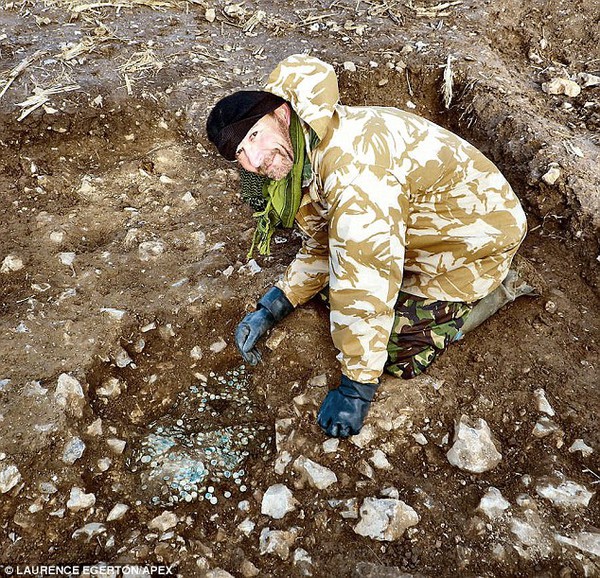An amateur archaeologist unexpectedly dug up a treasure trove of coins from ancient Rome.
Laurence Egerton, 51 years old, discovered the treasure when he searched for antiquities in the Seaton area, East Devon, England. The treasure includes 22,000 coins dating back to ancient Rome. Fearing the treasure was stolen, Mr. Egerton decided to camp on the spot for 3 days while other archaeologists continued digging for the treasure.
 Mr. Laurence Egerton found a treasure from ancient Roman times
Mr. Laurence Egerton found a treasure from ancient Roman times
Many archaeologists believe that this treasure may have been buried by an individual or an ancient Roman soldier. However, it has never been discovered until today. Not only is it the second largest treasure trove ever in England, this is also the most intact and valuable collection of the 4th century.
Before Mr. Egerton’s treasure, there were also two great treasures discovered, the Frome treasure. The Frome treasure is considered the largest treasure with 52,503 coins and the Nether Compton treasure with 22,703 coins unearthed.
 The treasure includes 22,000 ancient Roman coins
The treasure includes 22,000 ancient Roman coins
Until earlier this week, Mr. Egerton’s discovery was confirmed as a treasure after investigation results from Devon Coroner. This is an important condition for Mr. Egerton to be able to sell the treasure back to the museum. The value of the treasure will be evaluated by an independent organization – the Treasure Valuation Committee.
For comparison, the Frome treasure with 52,503 ancient coins costs 300,000 pounds (about 10.3 billion VND). Therefore, it is likely that Mr. Egerton’s treasure will be valued at about 100,000 pounds (nearly 3.43 billion VND). However, it must be admitted that the Frome treasure is more valuable because it contains a mixture of silver and gold.
The Royal Albert Memorial Museum has decided to spend money to buy this treasure to add to their collection of Romano-British antiquities.

Mr. Egerton discovered the treasure in November 2013. Then the coins were buried in a hole. Many archaeologists believe that there may have been a bag, but it has now decomposed. Archaeologists accompanying Egerton had to clean the coins for the investigation.
Mr. Egerton said that when he was detecting precious metals using the usual method, his machine suddenly signaled the presence of iron. Normally, he would ignore it, but this time, he decided to dig the ground right at that location. Immediately, he caught an iron bar covered above the coins.
Archaeologist Bill Horner estimates these Roman coins were made between 260 and 340 AD. They feature images of the Roman Emperor Constantine, his family, and his predecessors and successors. Bill Horner also said finding treasure in Devon is very unusual because the soil here is acidic, causing metal to corrode.
Museums are trying to raise money from society to buy back the treasure. The RAMM Museum alone persuaded Mr. Egerton to fully display the more than 1,500-year-old treasure so people could visit it for a few days.





